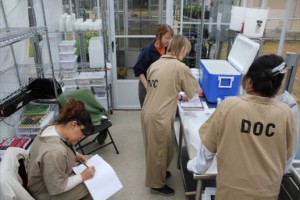 It’s springtime in the northwest. The endangered frog eggs are now tadpoles, and the butterflies are beginning to pupate. But the people tending to these ecological projects aren’t grad students or forest-loving yuppies. They’re prisoners in the care of the Washington State Department of Corrections, where the Sustainable Prisons Project is in its seventh year.
It’s springtime in the northwest. The endangered frog eggs are now tadpoles, and the butterflies are beginning to pupate. But the people tending to these ecological projects aren’t grad students or forest-loving yuppies. They’re prisoners in the care of the Washington State Department of Corrections, where the Sustainable Prisons Project is in its seventh year.
Back in 2004, the Washington State Department of Corrections started a partnership with the Evergreen State College. A forest ecologist, Nalini Nadkarni, brought together staff and incarcerated men from a nearby corrections center to start the Moss-in-Prison Project. Using prison facilities as a controlled environment, the project explored how to “farm” mosses for the horticulture trade.
In that pilot project, participants had to figure out which species of moss could be cultivated to alleviate pressures of unsustainable moss harvesting in old-growth forests. Nadkarni also intended to provide intellectual and emotional stimulation for the inmates, who typically have little or no access to nature but could provide fresh perspectives for ecological research. The project was a huge success, and one inmate even coauthored a peer-reviewed paper for an international sustainability journal with Nadkarni.
Now, the Sustainable Prisons Project works in four low-security corrections centers–and wants to go national. “We’ve been getting interest from correction centers, and around the world,” Kelli Bush, a project manager, says. “Our hope is to be able to share what we’ve learned in developing this program.”
The program also wants to show how prisons can have a positive impact on society. The inmates get connections to living things in a nature-starved environment, as well as knowledge and experience in green jobs–and the ecologists get a willing work force for sometimes-tedious work. They are in the process of evaluating whether participants have a lower rate of re-offending or a higher rate of employment upon release.
This year, inmates are working on several ecological projects. They have raised 311 Oregon Spotted Frogs in the past two years, bolstering local populations. Ecologists say that the frogs raised by the inmates grow bigger than those raised at other sites because the inmates have time to look at them every two hours and feed them at a higher rate.
Inmates are also raising native prairie plants, rearing Taylor’s Checkerspot butterflies, keeping bees, and building bird-boxes for endangered local birds. The projects are voluntary, says Bush, and the inmates have to apply for the jobs. Most of them have an interest, but no exposure to science or sustainability.
In addition to the hands-on experience, the project has held more than 100 lectures at five prisons, with more than 2,400 inmates and 280 corrections staff in attendance. The inmates can request topics for lectures, says Bush, and hot topics recently have been climate change, wildlife biology, and native plants.